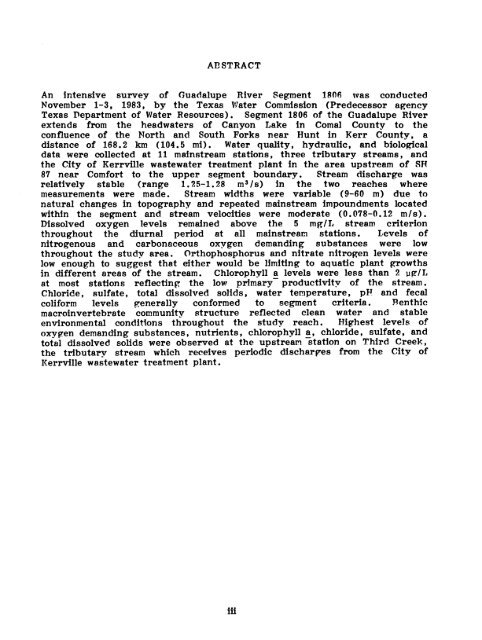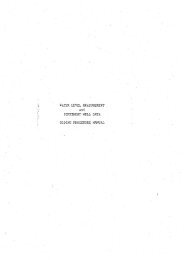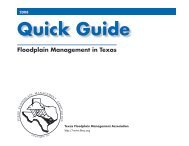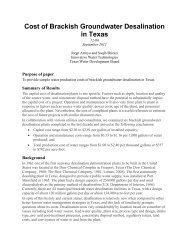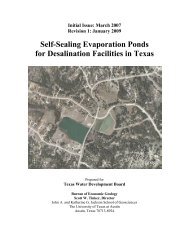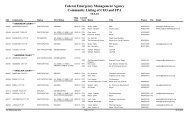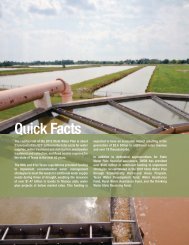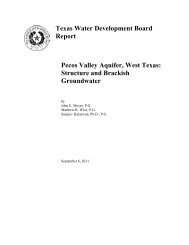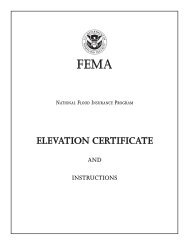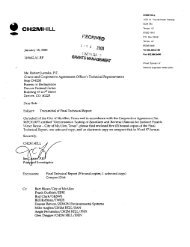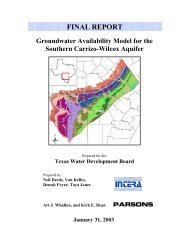Intensive Survey of the Guadalupe River Segment 1806
Intensive Survey of the Guadalupe River Segment 1806
Intensive Survey of the Guadalupe River Segment 1806
You also want an ePaper? Increase the reach of your titles
YUMPU automatically turns print PDFs into web optimized ePapers that Google loves.
ABSTRACT<br />
An intensive survey <strong>of</strong> <strong>Guadalupe</strong> <strong>River</strong> <strong>Segment</strong> <strong>1806</strong> was conducted<br />
November 1-3, 1983, by <strong>the</strong> Texas Water Commission (Predecessor agency<br />
Texas Department <strong>of</strong> Water Resources). <strong>Segment</strong> <strong>1806</strong> <strong>of</strong> <strong>the</strong> <strong>Guadalupe</strong> <strong>River</strong><br />
extends from <strong>the</strong> headwaters <strong>of</strong> Canyon Lake in Comal County to <strong>the</strong><br />
confluence <strong>of</strong> <strong>the</strong> North and South Forks near Hunt in Kerr County, a<br />
distance <strong>of</strong> 168.2 km (104.5 mi). Water quality, hydraulic, and biological<br />
data were collected at 11 mainstream stations, three tributary streams, and<br />
<strong>the</strong> City <strong>of</strong> Kerrville wastewater treatment plant in <strong>the</strong> area upstream <strong>of</strong> SH<br />
87 near Comfort to <strong>the</strong> upper segment boundary. Stream discharge was<br />
relatively stable (range 1.25-1.28 m3/s) in <strong>the</strong> two reaches where<br />
measurements were made. Stream widths were variable (9-60 m) due to<br />
natural changes in topography and repeated mainstream impoundments located<br />
within <strong>the</strong> segment and stream velocities were moderate (0.078-0.12 m/s).<br />
Dissolved oxygen levels remained above <strong>the</strong> 5 mg/L stream criterion<br />
throughout <strong>the</strong> diurnal period at all mainstream stations. Levels <strong>of</strong><br />
nitrogenous and carbonaceous oxygen demanding substances were low<br />
throughout <strong>the</strong> study area. Orthophosphorus and nitrate nitrogen levels were<br />
low enough to suggest that ei<strong>the</strong>r would be limiting to aquatic plant growths<br />
in different areas <strong>of</strong> <strong>the</strong> stream. Chlorophyll a levels were less than 2 yg/L<br />
at most stations reflecting <strong>the</strong> low primary productivity <strong>of</strong> <strong>the</strong> stream.<br />
Chloride, sulfate, total dissolved solids, water temperature, pH and fecal<br />
coliform levels generally conformed to segment criteria. Benthic<br />
macroinvertebrate community structure reflected clean water and stable<br />
environmental conditions throughout <strong>the</strong> study reach. Highest levels <strong>of</strong><br />
oxygen demanding substances, nutrients, chlorophyll a, chloride, sulfate, and<br />
total dissolved solids were observed at <strong>the</strong> upstream station on Third Creek,<br />
<strong>the</strong> tributary stream which receives periodic discharges from <strong>the</strong> City <strong>of</strong><br />
Kerrville wastewater treatment plant.<br />
iii


